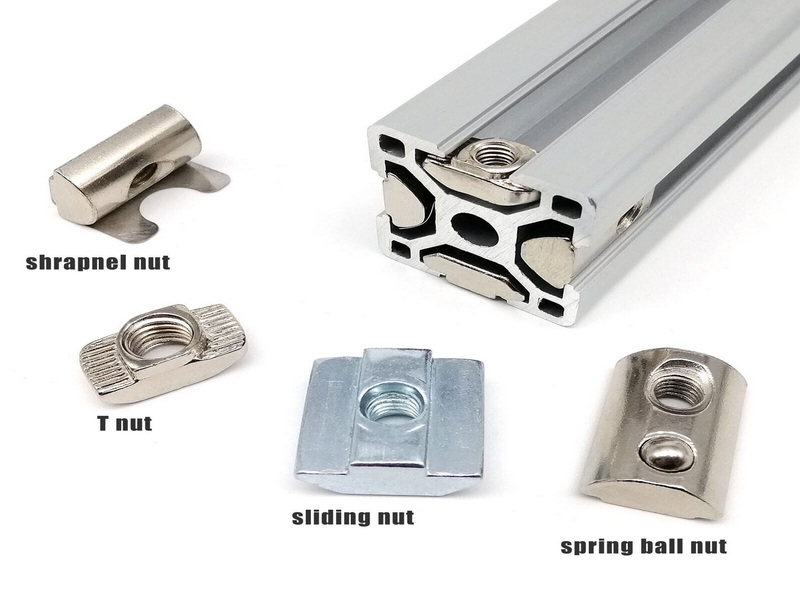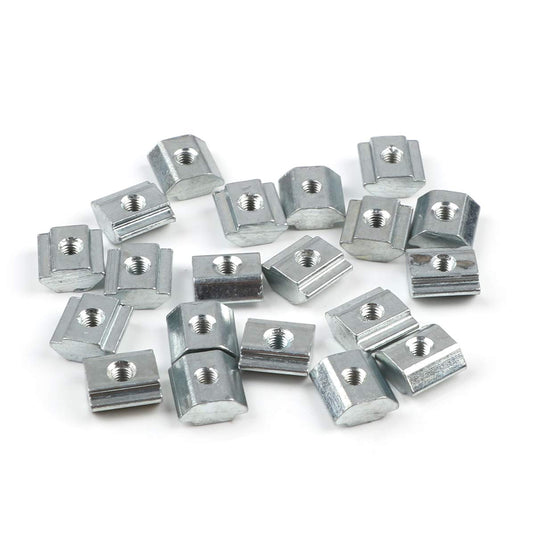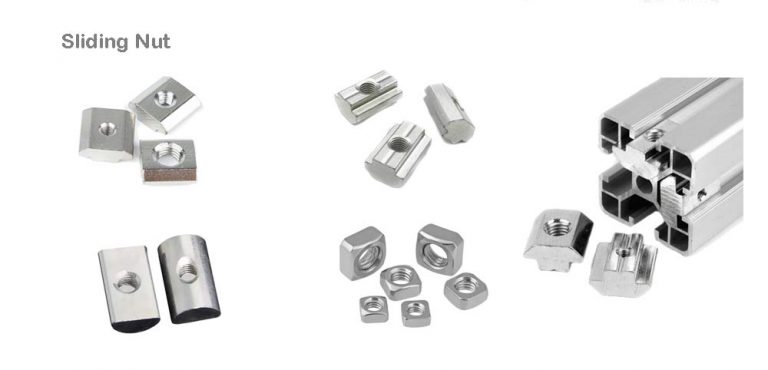Content Menu
● Introduction
● Types of Nuts Used in Aluminum Extrusion
>> T-Slot Nuts
>> Sliding Nuts
>> Pre-Assembly Nuts
>> Post-Assembly Nuts
>> T-Bolts
>> Flange Nuts
>> Elastic Bolts
>> Shrapnel Nuts
● Choosing the Right Fasteners
>> Application Requirements
>> Material Compatibility
>> Load Capacity
>> Ease of Installation
>> Cost-Effectiveness
● Installation Techniques
>> Step 1: Gather Your Tools
>> Step 2: Prepare the Aluminum Extrusion
>> Step 3: Insert the Nuts
>> Step 4: Secure the Fasteners
>> Step 5: Test the Assembly
● Benefits of Using Quality Nuts in Aluminum Framing
>> Enhanced Structural Integrity
>> Cost-Effectiveness
>> Flexibility in Design
>> Improved Assembly Efficiency
>> Resistance to Environmental Factors
● Conclusion
● Related Questions
>> 1. What are the advantages of using T-slot nuts in aluminum extrusion?
>> 2. How do sliding nuts differ from T-slot nuts?
>> 3. Can I use stainless steel nuts with aluminum extrusions?
>> 4. What factors should I consider when choosing nuts for my project?
>> 5. How can I ensure a secure installation of nuts in aluminum extrusions?
Introduction
Aluminum extrusion is a manufacturing process that shapes aluminum alloy into a desired cross-sectional profile. This versatile technique is widely used in various industries, including construction, automotive, and aerospace. One of the critical components in aluminum extrusion projects is the use of nuts, particularly T-slot nuts. These specialized fasteners play a vital role in ensuring the structural integrity and functionality of aluminum framing systems. In this article, we will explore what T-slot nuts are, their benefits, and how they enhance aluminum extrusion projects.

Types of Nuts Used in Aluminum Extrusion
When it comes to aluminum extrusion, several types of nuts are commonly used, each serving a specific purpose. Understanding these different types can help you choose the right fasteners for your project.
T-Slot Nuts
T-slot nuts are designed to fit into the T-slots of aluminum extrusions. They provide a secure anchoring point for bolts and other fasteners, allowing for easy assembly and disassembly. T-slot nuts come in various sizes and configurations, making them suitable for a wide range of applications. Their unique design allows them to slide into the T-slot and lock in place, providing a strong connection.
Sliding Nuts
Sliding nuts are another type of fastener used in aluminum extrusion. They are designed to slide along the T-slot, allowing for adjustable positioning. This feature is particularly useful in applications where components need to be repositioned frequently. Sliding nuts can be used in conjunction with T-slot nuts to create a flexible and adaptable assembly.
Pre-Assembly Nuts
Pre-assembly nuts are installed in the aluminum extrusion before the assembly process begins. This type of nut is ideal for projects where the assembly will be done in a controlled environment. Pre-assembly nuts help streamline the assembly process, reducing the time and effort required during installation.
Post-Assembly Nuts
Post-assembly nuts are installed after the aluminum extrusion has been assembled. This type of nut is useful for applications where access to the T-slot is limited. Post-assembly nuts can be tightened or loosened without disassembling the entire structure, making them a convenient option for maintenance and adjustments.
T-Bolts
T-bolts are another essential component in aluminum extrusion projects. They are designed to fit into the T-slot and provide a strong connection point for various components. T-bolts are often used in conjunction with T-slot nuts to create a secure and stable assembly.
Flange Nuts
Flange nuts feature a wide flange that distributes the load over a larger area, reducing the risk of damage to the aluminum extrusion. They are commonly used in applications where a secure connection is required, and they help prevent loosening due to vibration.
Elastic Bolts
Elastic bolts are designed to provide a flexible connection that can absorb shock and vibration. This feature makes them ideal for applications where movement or dynamic loads are expected. Elastic bolts can be used in conjunction with T-slot nuts to create a robust assembly.
Shrapnel Nuts
Shrapnel nuts are a unique type of fastener that provides a strong connection while allowing for easy installation and removal. They are often used in applications where frequent adjustments are necessary. Shrapnel nuts can be installed without the need for special tools, making them a convenient option for aluminum extrusion projects.
Choosing the Right Fasteners
Selecting the right fasteners for your aluminum extrusion project is crucial for ensuring a secure and stable assembly. Here are some factors to consider when choosing nuts for aluminum extrusion:
Application Requirements
Consider the specific requirements of your application. Different projects may require different types of nuts based on load capacity, adjustability, and environmental conditions. For example, if your project involves frequent adjustments, sliding nuts may be the best choice.
Material Compatibility
Ensure that the nuts you choose are compatible with the aluminum extrusion material. Using the right materials can help prevent corrosion and ensure a long-lasting connection. Stainless steel nuts are often recommended for aluminum applications due to their resistance to corrosion.
Load Capacity
Evaluate the load capacity of the nuts you are considering. Ensure that they can support the weight and stress of the components they will be securing. T-slot nuts and T-bolts are typically designed to handle significant loads, making them suitable for heavy-duty applications.
Ease of Installation
Consider the ease of installation when selecting nuts for your project. Some nuts, such as pre-assembly nuts, can streamline the assembly process, while others may require more time and effort to install. Choose fasteners that align with your project timeline and resources.
Cost-Effectiveness
Finally, consider the cost of the nuts and fasteners. While it may be tempting to choose the cheapest option, investing in high-quality fasteners can save you money in the long run by reducing maintenance and replacement costs.

Installation Techniques
Proper installation of nuts in aluminum extrusions is essential for ensuring a secure and stable assembly. Here is a step-by-step guide on how to install nuts in aluminum extrusions:
Step 1: Gather Your Tools
Before you begin, gather all the necessary tools, including a wrench, screwdriver, and any specialized tools required for your specific nuts. Having everything on hand will streamline the installation process.
Step 2: Prepare the Aluminum Extrusion
Ensure that the aluminum extrusion is clean and free of debris. Inspect the T-slots for any damage or obstructions that may hinder the installation of the nuts.
Step 3: Insert the Nuts
For T-slot nuts, slide them into the T-slot at the desired location. Ensure that they are oriented correctly to lock into place. For sliding nuts, position them in the T-slot and adjust as needed.
Step 4: Secure the Fasteners
Once the nuts are in place, use the appropriate bolts or screws to secure the components. Tighten the fasteners using a wrench or screwdriver, ensuring that they are snug but not overly tight, which could damage the aluminum extrusion.
Step 5: Test the Assembly
After installation, test the assembly to ensure that everything is secure. Check for any movement or looseness in the connections. If necessary, make adjustments to tighten the fasteners further.
Benefits of Using Quality Nuts in Aluminum Framing
Using high-quality nuts in aluminum framing systems offers several benefits that enhance the overall performance and longevity of the assembly.
Enhanced Structural Integrity
Quality nuts provide a secure connection that enhances the structural integrity of the aluminum extrusion. This is particularly important in applications where stability and strength are critical, such as in construction and automotive industries.
Cost-Effectiveness
Investing in quality nuts can lead to long-term cost savings. High-quality fasteners reduce the need for frequent replacements and maintenance, ultimately lowering overall project costs.
Flexibility in Design
The variety of nuts available for aluminum extrusion allows for flexibility in design. Whether you need adjustable components or fixed connections, there are nuts available to meet your specific requirements.
Improved Assembly Efficiency
Using the right nuts can streamline the assembly process, reducing the time and effort required to complete a project. Pre-assembly nuts, for example, can significantly speed up installation, allowing for quicker project turnaround times.
Resistance to Environmental Factors
Quality nuts are often designed to withstand various environmental factors, including moisture, temperature fluctuations, and corrosion. This durability ensures that the assembly remains intact and functional over time.
Conclusion
T-slot nuts and other fasteners play a crucial role in enhancing aluminum extrusion projects. By understanding the different types of nuts available and their specific applications, you can make informed decisions that improve the performance and longevity of your assemblies. Whether you are working on a construction project, automotive application, or any other endeavor involving aluminum extrusion, choosing the right nuts is essential for achieving optimal results.

Related Questions
1. What are the advantages of using T-slot nuts in aluminum extrusion?
T-slot nuts provide a secure anchoring point, allowing for easy assembly and disassembly. They enhance structural integrity and are available in various sizes and configurations to suit different applications.
2. How do sliding nuts differ from T-slot nuts?
Sliding nuts are designed to slide along the T-slot, allowing for adjustable positioning, while T-slot nuts lock into place for a secure connection.
3. Can I use stainless steel nuts with aluminum extrusions?
Yes, stainless steel nuts are often recommended for aluminum applications due to their resistance to corrosion and compatibility with aluminum materials.
4. What factors should I consider when choosing nuts for my project?
Consider application requirements, material compatibility, load capacity, ease of installation, and cost-effectiveness when selecting nuts for aluminum extrusion.
5. How can I ensure a secure installation of nuts in aluminum extrusions?
Ensure that the aluminum extrusion is clean, insert the nuts correctly, and tighten the fasteners snugly without over-tightening to avoid damaging the aluminum.






















